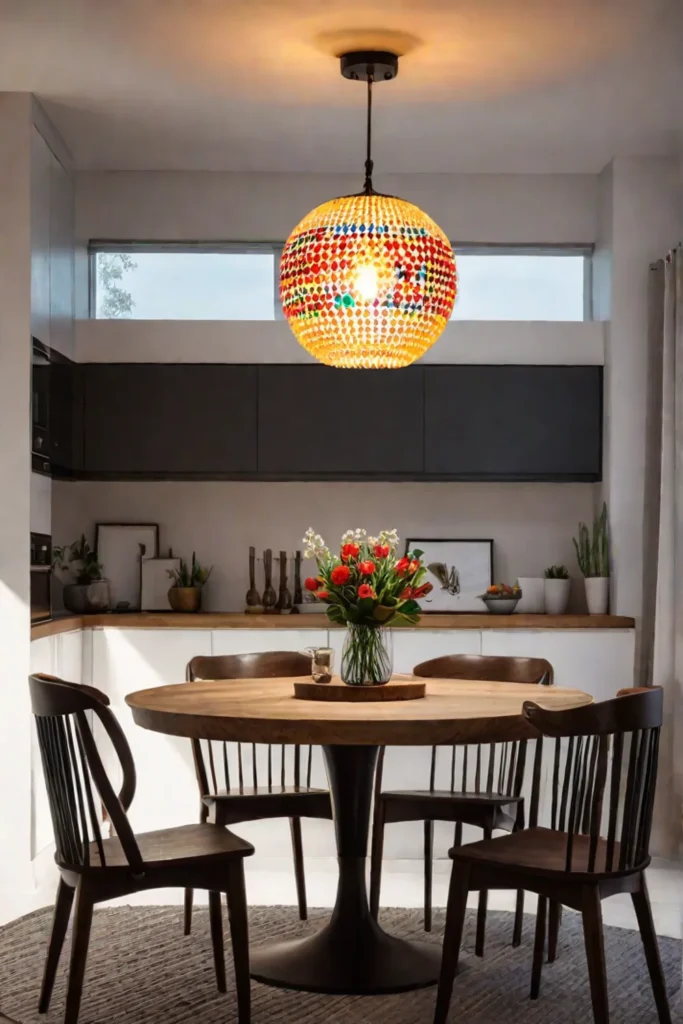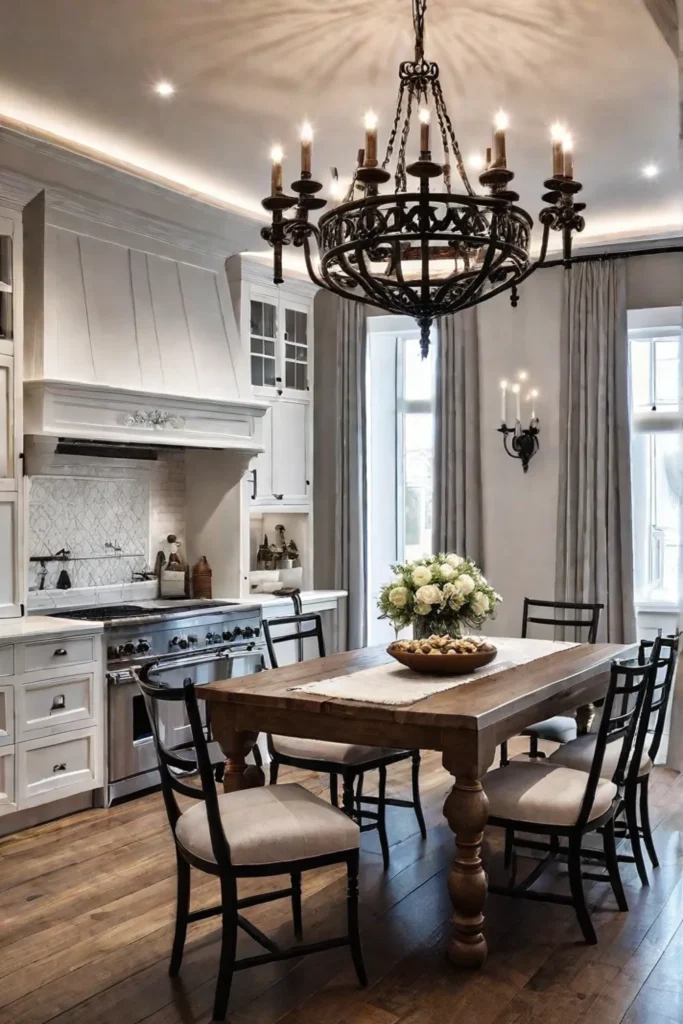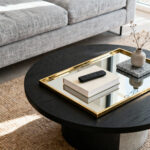Imagine walking into your kitchen and being greeted by a warm, inviting glow that sets the perfect mood for cooking, dining, and gathering with loved ones. The right kitchen light fixture can transform the entire space, elevating its functionality and aesthetic appeal. As someone passionate about creating beautiful and eco-conscious living spaces, I know firsthand how lighting can impact a room.
Whether renovating your kitchen or simply looking to refresh the look, choosing the perfect light fixture can be a game-changer. But with so many options out there, it can feel overwhelming to know where to start. That’s why I’ve compiled this comprehensive step-by-step guide to help you navigate the process and find the ideal kitchen light fixture for your home.

In the following sections, we’ll explore key factors, such as size, lighting type, style, placement, and even smart and dimmable features. By the end, you’ll have all the tools you need to make an informed decision and create a kitchen that is not only beautiful but also highly functional. So, let’s dive in and start your journey towards the perfect kitchen lighting!
Determining the Right Size for Your Kitchen
Size is one of the most important factors to consider when selecting a kitchen light fixture. After all, a fixture that is too large or too small can throw off the entire balance of the space. To get this right, we’ll need to start by measuring the dimensions of your kitchen.
Begin by measuring the width and length of your kitchen. This will give you a good idea of the overall size of the space you’re working with. Here’s a general rule of thumb to remember: the diameter of your light fixture should be approximately 1/2 to 2/3 the width of your kitchen table or island. For example, if your kitchen table is 48 inches wide, a suitable light fixture diameter would be between 24 and 32 inches.
But the size of your kitchen isn’t the only thing to think about. The height of your ceilings also plays a crucial role. As a general guideline, hanging fixtures should be positioned 30-36 inches above the kitchen counter or table. This helps to ensure proper illumination without creating any glare or discomfort.

Let’s say you have an open-concept kitchen that flows into other living spaces. In this case, you’ll want to consider the overall size of the space when selecting a light fixture. A larger fixture might be more appropriate for balanced lighting throughout the area.
By accurately measuring your kitchen dimensions and keeping these guidelines in mind, you’ll be well on your way to finding a light fixture that is perfectly proportioned for your space. Getting the size right is key to creating a cohesive and visually appealing kitchen design.
Choosing the Appropriate Lighting Type
With the size of your kitchen light fixture sorted out, let’s move on to the next important consideration: the type of lighting. You have three primary options for kitchen lighting: incandescent, LED, and fluorescent.
Incandescent bulbs are the traditional choice, known for their warm and inviting glow. However, they are less energy-efficient and have a shorter lifespan than other options. LED bulbs, on the other hand, are the modern-day superstar. They’re incredibly energy-efficient, can last up to 50,000 hours, and come in a wide range of color temperatures to suit your preferences.

Fluorescent lighting is another energy-efficient option but less commonly used in residential kitchens. Fluorescent bulbs can be a bit less aesthetically pleasing and may not provide the same quality of light as LEDs or incandescents.
When selecting the right lighting type, you’ll also want to consider brightness, energy efficiency, and color temperature. For kitchen spaces, you generally wish to have a brightness of around 300-500 lumens per square foot to ensure adequate illumination. Regarding color temperature, warm tones (2700K-3000K) are typically preferred to create a cozy and inviting atmosphere.
To help you visualize the differences, imagine a modern kitchen with sleek, minimalist LED strip lighting under the cabinets, providing focused task lighting. Pair that with a statement pendant light over the island, using a warmer color temperature to set the mood. Or picture a traditional kitchen with a classic, oil-rubbed bronze chandelier, emanating a cozy glow throughout the space.

The key is to balance tasks and ambient lighting to create a well-lit and functional kitchen. By considering the various lighting types and their unique characteristics, you can choose the perfect solution for your kitchen.
Selecting the Appropriate Style and Finish
Now that we’ve covered the essential factors of size and lighting type let’s dive into the world of style and finish. After all, the right kitchen light fixture can be the crowning jewel that ties the entire design together.
To start, take a good look around your kitchen and identify the overall design style. Is it modern and sleek? Traditional and cozy? Or perhaps a charming farmhouse aesthetic? Knowing the style of your kitchen will be the key to selecting a light fixture that complements it perfectly.

You’ll want to look for light fixtures with clean lines, minimalist designs, and finishes like brushed nickel or polished chrome for a modern kitchen. Think about sleek, linear pendants or recessed lighting that blends seamlessly into the ceiling.
On the other hand, if your kitchen has a more traditional vibe, you might be drawn to fixtures with a warm, classic look. Oil-rubbed bronze or antique brass finishes can add a touch of elegance, while a statement chandelier or pendant with intricate details can be the perfect focal point.
And for those with a farmhouse-inspired kitchen, consider rustic, industrial-style fixtures in finishes like black, copper, or even wood. These can create a cozy, inviting atmosphere and pair beautifully with shiplap walls, exposed beams, and other farmhouse-chic elements.
But the style and finish of your light fixture isn’t just about aesthetics – it’s also about balance and proportions. A fixture that is too large or too small for the space can destroy the entire visual harmony. Remember that general rule of thumb we discussed earlier – the diameter of your light fixture should be about 1/2 to 2/3 the width of your kitchen table or island.

Pendant lights are a particularly versatile option for kitchen lighting, as they can provide both task lighting and a stunning visual centerpiece. By carefully considering the size, style, and finish of your pendant light, you can elevate your kitchen’s entire look and feel.
Determining the Optimal Placement
Now that you’ve determined the size, lighting type, and style, it’s time to focus on the placement of your kitchen light fixture. After all, where you position your lights can make all the difference in functionality and visual appeal.
Let’s start with the placement of your pendant lights. As a general guideline, you’ll want to hang them 30-36 inches above the surface of your kitchen island or table. This allows for adequate clearance and ensures the light is directed where needed most – in your food preparation and dining areas.

The goal of task lighting, such as under-cabinet lights, is to position them at a comfortable height for the user. Typically, this means the bottom of the light should be level with the countertop or slightly below. This provides a focused, well-lit workspace for cooking and food prep tasks.
Now, if you have an open-concept kitchen that flows into other living spaces, you’ll need to consider the overall lighting scheme for the entire area. In this case, you might want to use dimmable or adjustable lights that can be tailored to create a cohesive and balanced ambiance throughout the space.
But it’s not just about functionality—the placement of your light fixtures can also significantly impact the visual balance and symmetry of your kitchen. Try to position your fixtures to create a sense of harmony and proportion. For example, you could hang pendant lights in a symmetrical arrangement over your kitchen island, or position recessed lights in a grid-like pattern across the ceiling.

By carefully considering the optimal placement of your kitchen light fixtures, you can create a space that is not only highly functional but also visually stunning. Remember, the right placement can make all the difference in transforming your kitchen into a true showpiece.
Incorporating Dimmable and Smart Lighting
As we near the end of our journey to finding the perfect kitchen light fixture, let’s talk about a feature that can truly elevate your space: dimmable and smart lighting.
Dimmable lighting is a game-changer when it comes to creating the right ambiance in your kitchen. By adjusting the brightness of your lights, you can set the perfect mood for different activities—from meal prep to cozy dinner parties. And the best part? Dimmable lighting can save you up to 40% on your energy consumption compared to non-dimmable fixtures.

Imagine having a sleek, modern pendant light over your kitchen island that you can dim to a soft, warm glow while enjoying a glass of wine with friends. Or picture your under-cabinet task lighting dimmed down just enough to provide a subtle, ambient light as you wind down for the evening.
But dimmable lighting is just the beginning. Smart lighting technology takes things to a whole new level. With smart lights, you can control the brightness, color temperature, and even scheduling of your kitchen lights – all from the convenience of your smartphone or voice commands.
Smart lighting can be integrated with other kitchen appliances and devices to create a truly connected and automated space. For example, your lights could turn on automatically when you enter the kitchen or dim down after a certain period of inactivity to save energy.
Not only do smart lighting features enhance the functionality of your kitchen, but they can also lead to long-term cost savings on your energy bills. Using sensors and automation, these intelligent systems can adjust the lighting based on your needs, reducing unnecessary energy consumption.
Whether you opt for dimmable, smart, or a combination, incorporating these advanced lighting features can truly transform how you experience your kitchen. It’s the perfect way to add that extra touch of sophistication and convenience to your space.
Maintenance and Longevity Considerations
When selecting the perfect kitchen light fixture, it’s important to also consider the long-term maintenance and longevity of your investment. After all, kitchens can be harsh environments, with exposure to moisture, grease, and heat—all of which can damage lighting.

Let’s start with the factors that can affect the lifespan of your kitchen light fixtures. Moisture from cooking and cleaning activities can cause corrosion and electrical issues, leading to premature failure. Grease and oil particles in the air can also build up on your fixtures, reducing their efficiency and overall lifespan.
And let’s not forget about the heat factor. Kitchens tend to be warmer than other rooms in the house, and high temperatures can cause light bulbs and fixtures to degrade faster.
Proper cleaning and maintenance techniques are essential to extend the life of your kitchen light fixtures. Start by regularly dusting your fixtures with a soft brush or microfiber cloth. For a deeper clean, use a mild detergent and warm water solution, then rinse and dry thoroughly.
Be mindful of the lifespan of different lighting types when it comes to bulb replacement. LED bulbs, for example, can last up to 50,000 hours – significantly longer than traditional incandescent or halogen bulbs. Replacing your bulbs regularly can help ensure your fixtures continue to perform at their best.
But it’s not just about the bulbs—the overall design and installation of your light fixture can also impact its longevity. Look for fixtures with smooth, easy-to-clean surfaces that won’t trap dirt and grime. Consider choosing fixtures that are easy to access and replace, such as those with screw-in bulbs or that can be easily removed from the ceiling.

By prioritizing maintenance, accessibility, and energy-efficient lighting options, you can help ensure your kitchen light fixtures last. This will save you money in the long run and help reduce your environmental impact. It’s a win-win for both your wallet and the planet.
Budgeting and Cost Considerations
As with any home improvement project, budgeting and cost considerations are crucial when selecting the perfect kitchen light fixture. The good news is that a wide range of options fit every budget, from affordable and practical to high-end and statement-making.
So, what factors can influence the cost of a kitchen light fixture? The size of the fixture is big – larger fixtures generally come with a higher price tag due to the increased materials and components required. The type of materials used in the construction can also impact the cost, with high-end options like crystal or brass being more expensive than common materials like glass or stainless steel.
The brand name of the fixture is another factor to consider. Well-known lighting brands often charge a premium for their products, capitalizing on their reputation for quality and design.
And let’s not forget about energy efficiency. While energy-efficient lighting options like LED may cost more upfront, they can provide significant long-term savings on your energy bills. So, weighing the initial investment against the potential for future savings is essential.

To find the right balance between quality, style, and budget, start by prioritizing your kitchen’s most important features. Do you value energy efficiency above all else? Or is the overall aesthetic of the fixture your top priority? Once you’ve identified your must-haves, you can compare different options and find the one that best fits your needs and your wallet.
Remember, it’s not just about the initial cost of the fixture – you’ll also want to factor in the long-term maintenance and replacement costs. Investing in a high-quality, energy-efficient fixture may cost more upfront, but it could save you money in the long run.
By carefully considering all the cost factors and finding creative ways to balance your budget, you can bring home the perfect kitchen light fixture that checks all the boxes – style, functionality, and value.
Putting It All Together: A Step-by-Step Guide
Whew, we’ve covered a lot of ground in our journey to finding the perfect kitchen light fixture! Now, let’s put it together in a comprehensive, step-by-step guide you can use as a roadmap for your kitchen lighting project.
First, you’ll need to measure the dimensions of your kitchen space. Grab a tape measure and jot down the width, length, and ceiling height. These measurements will be crucial in determining the right size of your light fixture.
Next, consider the type of lighting you want to incorporate. Do you prefer the warm, inviting glow of incandescent bulbs? Or are you drawn to the energy-efficient and long-lasting performance of LEDs? Think about the brightness, color temperature, and overall functionality you’re looking for.
With the size and lighting type sorted out, it’s time to focus on the style and finish of your fixture. Take a good look around your kitchen and identify the overall design aesthetic. Is it modern, traditional, or farmhouse-inspired? Selecting a fixture that complements the existing decor will help create a cohesive and visually appealing space.

Now, let’s talk about placement. Where will you position your light fixture? Hang pendant lights 30-36 inches above your kitchen island or table for optimal illumination. And don’t forget about task lighting – under-cabinet lights can be a game-changer for your food prep areas.
Consider incorporating dimmable and smart features to take your kitchen lighting to the next level. Dimmable lights allow you to set the perfect mood, while smart technology offers remote control and automation for enhanced convenience and energy savings.
As you make your selections, remember to factor in maintenance and longevity. Choose fixtures with easy-to-clean surfaces and accessible designs to simplify future upkeep. Also, be mindful of energy-efficient options that can save you money in the long run.
Finally, create a budget that balances your must-have features with your overall investment. Remember, a higher-quality, energy-efficient fixture may cost more upfront but could pay dividends.
By following this comprehensive step-by-step guide, you’ll be well on your way to finding the perfect kitchen light fixture that looks stunning and enhances your space’s functionality and ambiance. So, what are you waiting for? Let’s start transforming your kitchen into the heart of your home!
Conclusion
Choosing the perfect kitchen light fixture is an exciting and rewarding process that can truly elevate your space’s entire look and feel. By considering the key factors of size, lighting type, style, placement, and advanced features, you can create a beautiful and highly functional kitchen.

As an eco-conscious lifestyle blogger, I hope this step-by-step guide has given you the tools and information you need to make an informed decision. Remember, the right kitchen light fixture can become a stunning focal point reflecting your style and design aesthetic.
So, take a deep breath, grab your measuring tape, and prepare to embark on your journey towards the perfect kitchen lighting. With some planning and creativity, you can transform your kitchen into a warm, inviting, and visually stunning space that you’ll love spending time in.
Happy lighting!










